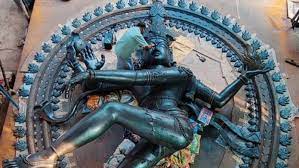The tallest “Nataraja” statue in the world commands attention at the G20 Summit location
An enormous “Nataraja” statue, said to be the largest in the world, is being painstakingly erected at the famous location of the forthcoming G20 Summit in an amazing demonstration of artistic skill and cultural importance. This magnificent 28-foot-tall statue, with its pedestal, was created utilizing the antiquated lost-wax metal casting method, evoking the exceptional workmanship of the renowned Chola bronzes from earlier in history.
The G20 Leaders’ Summit will be held at the Bharat Mandapam campus from September 9–10, and the “Nataraja” statue, a representation of Lord Shiva as the “lord of dance” and his cosmic power of creation and destruction, is expected to attract a sizable audience. According to PTI, Bharat Mandapam, a recently built international conference and exposition center at Pragati Maidan, has undergone a significant alteration along Mathura Road and is now decorated with G20 member country flags, creative logos, and posters with relevant themes.
A fascinating “Culture Corridor,” created by the Ministry of Culture, will be presented within Bharat Mandapam on the first day of the summit. The goal of this creative idea is to display the most priceless antiques from each of the 29 participating nations in one location, expressing the spirit of Vasudhaiva Kutumbakam, the G20’s underlying theme. The corridor also serves as evidence of the ability of culture to unite people, paying appropriate homage to the sub-theme of the G20 Culture Working Group under India’s leadership, “Culture Unites All.”
The ‘Culture Corridor – G20 Digital Museum’ will include tangible and digital items from G20 members and invited nations, constructing a cultural journey that G20 leaders will travel as they enter and exit the summit area. Yoga, the Kumbh Mela, Vedic chanting, and lost-wax bronze casting are just a few of the cultural gems that India has contributed to this worldwide endeavor. The ‘Nataraja’ statue is a witness to the lasting impact of the latter process.
The Cholas, whose bronze masterpieces are still prized today, are the source of the lost-wax method, a time-honored tradition in sculptural artistry. This complex metal casting process involves pouring molten metal, often bronze, gold, or silver, into a mold made of wax or other similar resin-like materials. The wax model is melted and removed once the metal cools and hardens, revealing the magnificent artwork.
P K Mishra, the Prime Minister’s Principal Secretary, supervised the installation of the Nataraja monument at the ninth meeting of the G20 coordination committee, making sure that every aspect matched the importance of the event. The 10,000 square foot “Culture Corridor” exhibition will be located in the corridor next to the summit chamber and will include a mesmerizing immersive zone with a mega-screen projection.
Manuscripts of the Rig Veda from India, a rare copy of the Magna Carta from the UK, an anamorphic digital image of the Mona Lisa from France, certified original copies of the Charters of Freedom from the US, and a fahua lidded jar from China are just a few of the carefully chosen artifacts to be displayed in the “Culture Corridor,” which offers a global mosaic of cultural treasures.
The Indian Prime Minister and Indian President meet with international leaders and their spouses in front of backdrops created by the Ministry of Culture, in addition to the “Culture Corridor.” A diverse program is also being planned for the closing supper of the G20 leaders, their wives, and other VVIPs. A display honoring India as the “Mother of Democracy” will also recount the country’s rich 5,000-year history and its steadfast adherence to democratic values. With the help of the global language of culture and heritage, this mosaic of creative and cultural manifestations aims to give the G20 Summit more depth and significance.







